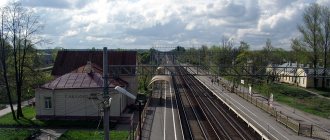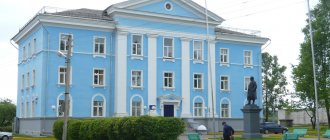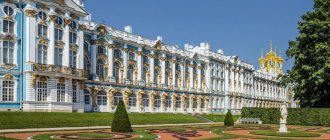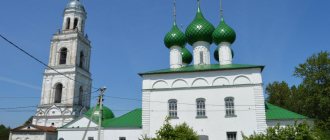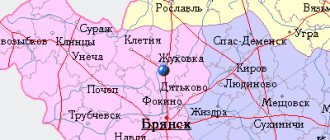Zaoksky district
We continue to travel around the Tula region. Let's go to Zaoksky district with Masha Kucherova!
- Clean air, Oka, incredible open spaces - it’s impossible not to love this region. The area is famous for its famous natives: Andrei Bolotov, Vasily Polenov and Vsevolod Rudnev. Three completely different people contributed to the development of our country and left behind wonderful places in their native land. Go!
In terms of tourism, the Zaoksky district is, first of all, three magnificent places that cannot be ignored: Dvoryaninovo, Polenovo and Savino. To be here and not visit them is a real cultural crime. We couldn’t afford this, so we decided to go around them all in one day.
By the way, summer is the best time for this region. It is at this time of year that the air is filled with dizzying aromas of herbs and flowers, the hills are covered with giant emerald-colored carpets, and a saving coolness blows from the river.
In short, if you don’t yet know where to go on the weekend, then you already know where to go on the weekend!
The first point of our route was the museum of Rear Admiral Vsevolod Fedorovich Rudnev in the village of Savino.
At the turn we were greeted by a branded stop with painted portholes and the sea. And the St. Andrew's flag proudly fluttered above it. So, we're going right!
The museum was opened, by the way, not so long ago. It has existed only since 2004, having celebrated its first round date last year. What’s gratifying is that it is headed by former sailor Evgeny Zhuldybin, because such a museum undoubtedly needs a sea soul.
The museum itself is small, but very cozy. In the large round hall, signal flags hang from the ceiling, there are anchors, and in the windows you can look at all sorts of things, one way or another connected with the legendary cruiser.
In the next room - the wardroom - you can admire the model of the Varyag and even ring the ship's bell. The museum is located in close proximity to the grave of the rear admiral, at the southern wall of the Church of the Kazan Icon of the Mother of God, now restored and operational. In 1992, a monument to Rudnev was erected at the grave. And from the museum you can go down to a small pond and a font.
The salty wind may not blow here, but for a second you can believe that you are on the shore of some distant body of water. So all sea fans are welcome!
After Savino, we went to the homeland of the famous agronomist and inventor Andrei Timofeevich Bolotov to the Dvoryaninovo estate. It must be said right away that what is more interesting is not even the place itself, but the personality of this person. “Russian writer, memoirist, moral philosopher, scientist, botanist and forester, one of the founders of agronomy and pomology in Russia” - this is what Wikipedia says about him.
Bolotov studied all branches of agriculture, wanting to turn his native estate into a real paradise on earth. He grew hundreds of all kinds of crops, developing new varieties of vegetables and fruits.
By the way, thanks to Andrei Timofeevich, potatoes began to spread in Russia.
There is a funny story connected with it. Initially, everyone was very afraid of a strange product: how is it that you plant one “seed”, and then several come out at once, and this all happens underground. Well, definitely the machinations of evil spirits! And then Bolotov resorted to a trick. Having dug up the already grown potatoes, he dumped them in one hole and placed a guard there. Here the peasants were already interested: what is it, since it is so well guarded? And they slowly stole potatoes from the pit. And then, having tried it at home, we realized that it was a tasty and satisfying meal.
Bolotov wrote a lot of works on economics and housekeeping. In general, he was a very smart man. A tour of his house only confirms this.
By the way, all guests will be given the famous “Bolotovsky” tea - an infusion of herbs that give youth and health. We tried it: we don’t know about the healing properties, but that’s for sure that it’s delicious! It’s nice to walk around the area here: everything blooms, grows and smells. And there is also a giant oak tree, which was struck by lightning many years ago, making a kind of arch out of it.
They say that if you stand under this oak tree and make a wish, it will definitely come true. We made a wish!
Having said goodbye to the museum, its hospitable employees and furry residents - the characteristic cat Vasily Dmitrievich and the good-natured dog Ryzhik (hugging them is a completely free pleasure!), we moved on.
At the end of the trip, we left perhaps the most popular place in the Zaoksky district - the estate of the great artist V. D. Polenov.
Surprisingly, at the height of a weekday there were really a lot of people here. They did not enter the house-museum of Vasily Dmitrievich itself - there was a queue to enter. But even without it you can get tremendous pleasure from walking around the territory.
True, there are warnings everywhere: do not go on the grass, there may be snakes there. Our attentiveness has increased significantly. :)) But apart from two huge snails, we couldn’t see anyone.
By the way, don’t forget to take your swimwear with you: you’ll never forgive yourself if you go to the banks of the Oka River and don’t take a swim!
And of course, walking around the estate, you understand that it is impossible to live here and not be inspired by such views.
For inspiration, creativity, feast for the eyes and an incredible atmosphere of calm, harmony and silence - visit the Zaoksky district. We recommend!
Already published gulbaria for the Tula region:
Aleksin Arsenyevo Belev Belev-2 Bogoroditsk Byaki Venev Donskoy Epifan Efremov Kireyevsky district Krapivna Kolosovo Bald Mountain Novomoskovsk Odoev Perevoloki-Vozvratnye Plavsk Pytal Suvorov Tarusa Uzlovaya Manor house Berov Ushakovsky open-pit mine (lakes) Fedyashevo Khruslovka Chekalin Chern Yasnogorsk
Gallery
show all photos
Survey
Which place and museum do you prefer?
Car washes
- Car wash on Nechaevskoye Highway, 4. www.Moika71.rf . Wide range of services. Low prices. Discounts. Car wash address: Zaoksky village, Nechaevskoe highway, 4. Car wash phone number: +7-915-680-39-00. View the car wash website on the Internet (link).
- Truck car wash. Washing trucks up to 3 meters high. Cargo car wash address: Zaoksky village, Nechaevskoe highway, 4. Car wash phone number: +7-915-680-39-00. View the cargo wash website on the Internet (link).
Sights of the Tula region
Novosiltsev estate in Yesukovo
where: Russia, Tula region, Yasnogorsk district, Yesukovsky
address: Russia, Tula region, Yasnogorsky district, Yesukovsky village
type: Sights, Estates
| Spring of Saint Euphrosyne where: Russia, Tula region, Aleksinsky district, Kolyupanovo address: Russia, Tula region, Aleksinsky district, Kolyupanovo village type: Sights, Temples | |
| Ryurikovo station where: Russia, Tula region, Aleksinsky district, Rurikovo address: Russia, Tula region, Aleksinsky district, village at Ryurikovo station type: Sightseeing | |
| Ancient fortress on Ilyinskaya Mountain where: Russia, Tula region, Aleksinsky district, Aleksin address: Russia, Tula region, Aleksinsky district, Aleksin type: Sightseeing | |
| Forgotten city where: Russia, Tula region, Dubensky district, Koptevo address: Russia, Tula region, Dubensky district, Koptevo village type: Sightseeing | |
| All inclusive tours 2022! Holidays in Crimea, Abkhazia, Moscow region! | |
| Creative where: Russia, Tula region, Zaoksky district, Nechaevskie Vyselki address: Russia, Tula region, Zaoksky district, Nechaevskie Vyselki telephone type: Sightseeing | |
| Mother of God Panteleimon Shcheglovsky Monastery where: Russia, Tula region, Tula address: Russia, Tula st. Lisa Chaikina 1 telephone type: Sights, Temples | |
| Abandoned airfield bunker where: Russia, Tula region, Yasnogorsk district, Bashino address: Russia, Tula region, Yasnogorsky district, Bashino village type: Sightseeing | |
| Church of St. John the Baptist where: Russia, Tula region, Novomoskovsky district, Ivan-Ozero address: Russia, Tula region, urban district City of Novomoskovsk, village Ivan-Ozero type: Sights, Temples | |
| 100-year-old oak tree in Yasnaya Polyana where: Russia, Tula region, Shchekinsky district, Yasnaya Polyana address: Russia, Tula region, Shchekinsky district, Yasnaya Polyana type: Sightseeing | |
| Belevsky Spaso-Preobrazhensky Monastery where: Russia, Tula region, Belevsky district, Belev address: Russia, Tula region, Belev, Metropolitan Evlogiya street type: Sights, Temples | |
| Monument to V.I. Lenin in Yasnaya Polyana where: Russia, Tula region, Shchekinsky district, Yasnaya Polyana address: Russia, Tula region, Shchekinsky district, Yasnaya Polyana type: Sights, Monuments | |
| School named after L.N. Tolstoy where: Russia, Tula region, Shchekinsky district, Yasnaya Polyana address: Russia, Tula region, Shchekinsky district, Yasnaya Polyana village type: Sightseeing | |
| Nikolaevskaya bell tower where: Russia, Tula region, Venevsky district, Venev address: Russia, Tula region, Venev, st. L. Tolstoy type: Sights, Temples | |
| Unfinished swimming pool on the territory of Yasnaya Polyana where: Russia, Tula region, Shchekinsky district, Yasnaya Polyana address: Russia, Tula region, Shchekinsky district, Yasnaya Polyana type: Sightseeing | |
| Monument to the "tail" where: Russia, Tula region, Tula address: Russia, Tula, Lenin Avenue, building 84, building 1 type: Sights, Monuments | |
| "Beaver" bridge where: Russia, Tula region, Shchekinsky district, Zakharovka d address: Russia, Tula region, Shchekinsky district, Zakharovka village type: Restaurants | |
| Megalith "Horse Stone" where: Russia, Tula region, Efremovsky district, Kozye s address: Russia, Tula region, Efremovsky district, Kozye village type: Sightseeing | |
| Manor of Karl von Meck where: Russia, Tula region, Venevsky district, Khruslovka address: Russia, Tula region, Venevsky district, Khruslovka village type: Sights, Estates | |
| Church of the Intercession of the Blessed Virgin Mary in Romanovo where: Russia, Tula region, Kireyevsky district, Romanovo address: Russia, Tula region, Kireevsky district, Romanovo village type: Sights, Temples | |
www.domotdiha.ru
City `s history
The territory where the workers' settlement arose belonged to the Aleksinsky district, which became part of the Grand Duchy of Moscow back in the 14th century.
Despite the fact that this area already belongs to the forest zone, its settlement was complicated by Tatar raids. In the raid of 1472, the district center of Aleksin was destroyed. The campaign of Khan Akhmat in 1480, which ended with a stand on the Oka, and then on the Ugra and complete defeat, hardly allowed the lands beyond the Oka to be populated. The raid of 1492 shows the extremely weak population of the area south of the Oka. Therefore, the settlement of the region began only from the very end of the 15th - beginning of the 16th centuries. Information about the emergence of the parish, which included in the 19th century. included the village of Ivanovka and the station. Ivanovo (then Tarusskaya station) of the Moscow-Kursk railway dates back to the end of the 17th century - this is the village. Unki" By the Decree of the Presidium of the Supreme Soviet of the RSFSR of January 12, 1965, rural areas were transformed into districts, industrial areas were liquidated and a number of new districts were formed, including Zaoksky. By the decision of the Tula Regional Executive Committee of January 13, 1965, the following village councils were included in the newly formed Zaoksky district: Aleksandrovsky, Butikovsky, Gatnitsky, Dmitrievsky, Zaoksky, Iskansky, Kotovsky, Malakhovsky, Simonovsky, Strakhovsky and Yakovlevsky of the former Laptevsky rural district. By the decision of the Tula Regional Executive Committee. Zaokskoye and the village. d. st. Tarusskaya of the Zaoksky village council was united for the second time into one settlement of Zaokskoye. This settlement, classified as a workers' settlement, was given the name r. village Zaoksky. In the early 70s the village. 3aoksky. paved. Modern buildings began to be erected there. On Pionerskaya Square, the central one in the village, the buildings of the district party committee, the district executive committee, and a cinema were built. At this time, the village expanded significantly to the west. On the site of the fields, two-story residential buildings, a high school building and a children's factory grew up. On the street Polenov, a two-story department store was built. Behind the village, in a forested area, a three-story central regional hospital appeared.
